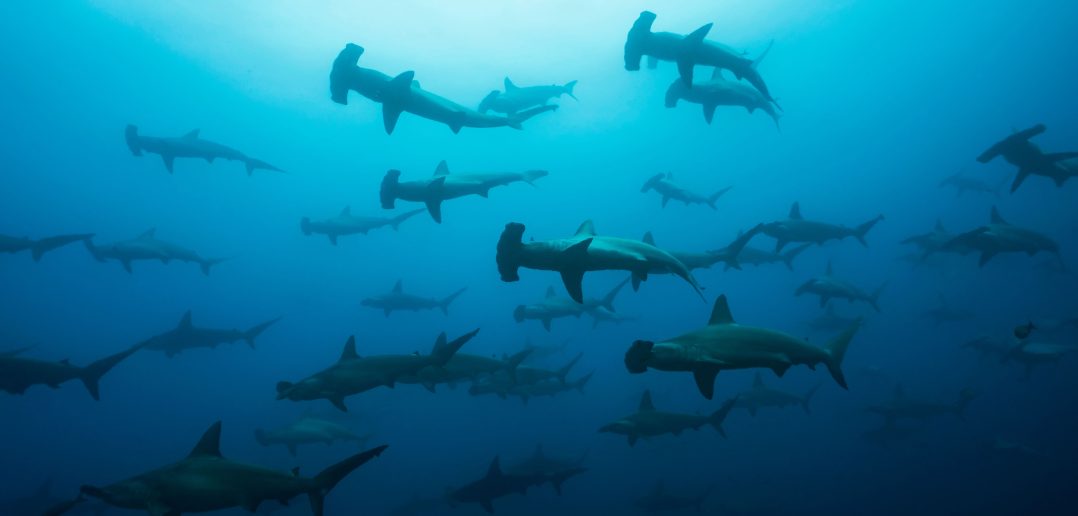Where do hammerhead sharks go at night? And perhaps more importantly, why? That's what Research Scientist and Professor Alex Hearn of the Galapagos Science Center hoped that a team of SAS analytics volunteers would be able to answer by analyzing data he's collected over nearly two decades.

The project is part of a data for good partnership between SAS and the UNC Center for Galapagos Studies that also includes projects about sea turtles and phytoplankton populations.
Learning more about these sharks’ movement patterns is essential to protecting them. Hammerheads are an increasingly targeted species by commercial and illegal fisheries for their fins and are very vulnerable to being caught as bycatch by trawls, purse-seine nets, gillnets and longlines.
“Where sharks aggregate,” Hearn says, “they’re vulnerable.”
Insights and challenges to tracking hammerhead sharks in the Galapagos
Since 2006, Hearn, his partners at the Galapagos National Park, and the MigraMar network of scientists have gathered telemetry data to track the movements of almost 200 tagged hammerhead sharks. Those sharks live around the remote Darwin and Wolf islands of the Galapagos archipelago approximately 150 kilometers (93 miles) northwest of the main islands, as well as two additional locations closer to the main islands.
During the day, sharks generally move inshore near the rocky areas and coral reefs close to the islands, and at night when they tend to feed, they move offshore. However, these movement patterns are not always consistent, and the reasons for them remain unknown.
Plus, the Galapagos Marine Reserve, where the sharks are protected, isn’t large enough to capture all their offshore movements.
“So that’s one thing,” Hearn says, “and the other thing is, what triggers them to move offshore, and are those triggers likely to change at any point due to climate change, El Niño events, or anything else? Then can we adapt our protection to account for those triggers.”
Using analytics to visualize hammerhead shark movement
The team used SAS® analysis and visualization software to identify and characterize inshore and offshore hammerhead shark movement patterns.
That included analyzing factors such as whether predictable daily patterns existed, whether they occurred individually or in groups, and what other factors – like lunar cycles, environmental changes and individual needs – might influence these patterns.
Then based on these known movement categories, the volunteers set out to answer the bigger question: Are these patterns not only present but quantifiable?
The SAS team created three sets of visualizations. The first displays the Fast Fourier analysis results using SAS Visual Analytics on SAS® Viya®. Tabbed dashboards allow users to select between individual islands, island comparisons, individual sites, site comparisons, individual sharks and shark comparisons.
A second dashboard features Bayesian network graphics that identify important variables and relationships between variables. The model predicted sharks to be offshore with 93.24% accuracy and onshore with 93.73% accuracy.
They used the third set to create a public-facing website that allows users to select specific islands, date ranges or time ranges and see those results displayed in bubble plots on maps. The team designed it as a prototype to demonstrate how to present the data to general audiences, such as elementary or high school students or park visitors.
“I never in my wildest dreams would have thought that I could have a team like this getting into my data and extracting [insights],” Hearn says. “This is stuff that I’ve been wanting to do for at least 10 years and just not had the opportunity. So, it’s really cool to see it play out.”
Marti the hammerhead shark: From children’s books to creating change
Sometimes the data visualizations produced more questions than answers – like, can sharks sense a tsunami before it happens or are they simply reacting to it? – but that’s ok with Hearn.
The plan is that the project will ultimately lead to a scientific publication. In the meantime, the analytics work, while itself complex, can serve a simple purpose.
“What we’re trying to do with our information is to turn it into a story that can be understood at different levels,” Hearn says.
While he will use it in conversations with policymakers like Ecuador’s Minister of Environment and Vice Minister of Aquaculture and Fisheries, that story also needs to resonate with a much younger audience – as in 9-year-olds.
The Galapagos Conservation Trust and Galapagos Science Center have already published an educational children’s book, Marti the Hammerhead Shark, which follows a young hammerhead’s illustrated journey across the Pacific Ocean – including all the perils she faces along the way. Hearn envisions potentially using the insights gleaned from this project as the basis for a sequel.
Educating those kids isn’t just for fun: That information trickles up to their parents, and one day the children will be fishing the waters, so teaching them the importance of protecting hammerheads can create real change now and in the future.
Generating this type of awareness from grade schools to government ministries helps make sure Hearn and his fellow conservationists aren’t kept up at night, regardless of where those hammerhead sharks might be at the time.


1 Comment
Could you provide a link to the website, so we can see what it's like ... "They used the third set to create a public-facing website".